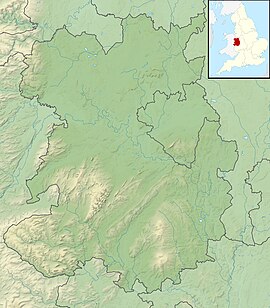Titterstone Clee Hill
| Titterstone Clee Hill | |
|---|---|

The summit under snow, with radar station beyond.
|
|
| Highest point | |
| Elevation | 533 m (1,749 ft) |
| Prominence | 232 m (761 ft) |
| Parent peak | Brown Clee Hill |
| Listing | Marilyn |
| Coordinates | 52°23′51″N 2°36′09″W / 52.39758°N 2.60252°WCoordinates: 52°23′51″N 2°36′09″W / 52.39758°N 2.60252°W |
| Geography | |
| Location | Shropshire, England |
| Parent range | Shropshire Hills |
| OS grid | SO591779 |
| Topo map | OS Landrangers 137, 138 |
Titterstone Clee Hill, sometimes referred to as Titterstone Clee or, incorrectly, Clee Hill (which is the lower hill to the southeast), is a prominent hill in the rural English county of Shropshire, rising at the summit to 533 metres (1,749 ft) above sea level.
It is one of the Clee Hills, in the Shropshire Hills Area of Outstanding Natural Beauty. The nearest town to the hill is Ludlow, which can be seen from parts of Cleehill village.
Titterstone Clee is the third-highest hill in Shropshire, beaten only by the nearby Brown Clee Hill (540 metres (1,770 ft)) and Stiperstones (536 metres (1,759 ft)). Much of the higher part of the hill is common land, used for the grazing of sheep, air traffic control services and both working and disused quarries. The summit of Titterstone Clee is bleak, treeless and shaped by decades of quarrying. Many of the industrial structures still remain, and lend to the ghostly atmosphere of the hill top, especially during the prolonged winter fogs that descend over these hills.
Investigations have led to some individuals to claim that Titterstone Clee was once an active volcano. However, this was conclusively shown to be incorrect in the 1930s when exposures clearly revealed an intrusive origin for the igneous rock which is found beneath the higher ground. Locally this is known as "Dhu Stone" (Welsh for Black Stone); geologically it is an olivine basalt, sometimes coarse enough to be a dolerite. It appears to have been intruded as a sill between sandstone layers within the unconsolidated strata of the Middle Westphalian soon after deposition of the latter.
The weather on Titterstone Clee Hill can be particularly hazardous, with locally infamous fog and drizzle being commonplace. Snow and ice can also cause problems in winter, as well as gales.
...
Wikipedia

